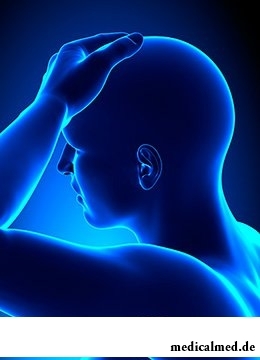





Dystonia
 Motive at which there is a spasmodic or continuous reduction of muscles forcing the patient to accept violently pathological poses and to reproduce the uncontrollable movements call dystonia.
Motive at which there is a spasmodic or continuous reduction of muscles forcing the patient to accept violently pathological poses and to reproduce the uncontrollable movements call dystonia.
Disturbance of interaction between activation and relaxation of muscles because of what there is an uncontrollable and involuntary reduction, both separate muscles, and the whole groups acts as a cause of illness.
The modern medicine cannot answer yet a question why there is a disturbance of this interaction therefore unambiguously it is impossible to tell about dystonia syndrome origins. The disease has no specific electrophysiologic, biochemical, pathomorphologic and other diagnostic markers.
According to statistical data, about 1% of all world's population suffers from a syndrome of dystonia. And at women the disease meets many times more often, than at men.
Dystonia forms
Etiological classification of a disease is not up to the end developed presently, generally it includes 4 sections, however in some sources it is possible to meet still the fifth form of a disease – pseudo-dystonia. Understand the syndrome arising against the background of diseases which can remind dystonia, however, in fact, it not being (Sandifer's syndrome, Isaaksa, etc.) as it
Allocate primary and secondary dystonias – the first is not connected with other neurologic deviations, the second develops against the background of damage of tissue of head and spinal cord, peripheral nerves and as a result of influence of external environment.
Primary dystonia can be shown both at children's age, and in mature, it represents group of hereditary diseases which can be transmitted on autosomal recessively, autosomal dominantly or to the H-linked mode of inheritance and to be combined with a tremor, parkinsonism or a moikloniya.
Secondary dystonia can arise owing to hereditary metabolic diseases, at injuries, a poisoning with carbon monoxide, a stroke or a subdural hematoma.
On the basis of prevalence in medicine allocate the following forms of a syndrome of dystonia:
- Segmented – at which symptoms of dystonia are observed in two adjacent parts of a body;
- Focal – the disease is observed in any one part of a body, it is designated on the area struck with a syndrome (cranial, axial, cervical, etc.);
- Generalized – at which the patient has an opportunity to weaken the involuntary movements by corrective gestures;
- Gemidistoniya – manifestation of the syndrome consisting of kruralny and brachial dystonia on one half of a body;
- Multifocal – at this form of dystonia symptoms are distributed in two and any more adjacent each other parts of a body.
In turn focal dystonia is subdivided into the following forms:
- Cervical;
- Nictitating spasm;
- Kruralny;
- Writer's cramp;
- Oromandibulyarny;
- Spastic.
On an etymological sign allocate such form of a disease as Dystonia plus which is understood as association of group of the diseases which are not relating to primary and secondary forms.
Dystonia symptoms
Clinical manifestations of a syndrome depend on a disease etiology. So symptoms of dystonia, depending on the place of defeat, are:
- Feet – the expressed bending of toes, extension and podvorachivany extremities;
- Brushes – bending with overextension of fingers;
- Neck and trunk – rotary motions;
- Front area – protrusion of language, a zazhmurivaniye of eyes, the forced closing or opening of a mouth, a pulling of lips.
Symptoms of dystonia are also states at which the patient accepts unnatural disabling poses. In all cases these manifestations completely disappear at relaxation and during sleep.
Diagnosis of dystonia
It is possible to diagnose primary form of a disease only clinically, it is possible to distinguish symptoms of dystonia secondary only after carrying out according to indications of a wide range of researches.
In many cases genetic inspections, cytologic and biochemical analysis of a bioptat of fabrics, biochemical researches and other paraclinic diagnostic methods are required.
Also detailed poll of the patient from the attending physician as it considerably increases chances of adequate clinical diagnosis of a disease is required.
Treatment of dystonia
At a disease apply drug or surgical treatment. Originally in hospital check reaction of an organism to treatment of dystonia the Levodopa or agonists of dopamine receptors. If it negative, apply cholinolytics, Carbamazepine, Baclofenum and benzodiazepines with long action.
 Trial treatment by various medicines has to be carried out systematically for exact definition whether such therapy renders the necessary effect. Use of trial drug treatment of dystonia at children's age has to last not less than half a year as the therapeutic effect at this group of patients can be shown not at once.
Trial treatment by various medicines has to be carried out systematically for exact definition whether such therapy renders the necessary effect. Use of trial drug treatment of dystonia at children's age has to last not less than half a year as the therapeutic effect at this group of patients can be shown not at once.
Surgical treatment of dystonia represents carrying out a stereotaxic talamotomiya or pallidotomiya which are applied only in the most hard cases. Focal dystonia treat by means of local introduction to the muscles involved in a hyperkinesia, botulotoxin everyone two or four months. Side effects at this type of treatment are minimized.
Understand motive neurologic frustration because of which there are spasmodic or continuous reductions of muscles forcing the person to accept unnatural poses and to reproduce the uncontrollable movements by various parts of a body as dystonia. The disease demands careful clinical diagnosis with carrying out a number of analyses and researches, and also purposes of adequate drug or surgical treatment.
Except people, only one living being on the planet Earth – dogs suffers from prostatitis. Here really our most loyal friends.

The popular expression "run from a heart attack" became the motto of the people supporting active lifestyle. Moreover, run became peculiar...
Section: Articles about health
Coffee - the tonic loved by many for the invigorating aroma and deep taste. Having the stimulating effect, coffee increases working capacity, promotes concentration of attention, fights against drowsiness and improves mood. Statistically, about 30% of inhabitants...
Section: Articles about health
For the city dweller the fitness is the most convenient sport. It is enough to acquire the subscription to the gym to get access to various apparatuses and an opportunity to train under the leadership of the experienced consultant. Many consider fitness the best way of maintenance of physical shape and receiving dynamic loads which the people occupied preferential with brainwork so need. Nevertheless, representations of most of consumers of similar services about специф...
Section: Articles about health
The metabolism at each person proceeds in own way. However dependence between the speed of this process and disposal from superfluous in...
Section: Articles about health
Almost each of us during life faced dissatisfaction with own body. At such moments, as a rule, we begin to shame ourselves, urgently we go on the most rigid diet promising minus of 10 kg in a week, or we exhaust ourselves in the gym to полусм...
Section: Articles about health
The cosmetics intended for improvement of a condition of skin, nails and hair are used by each woman. Expenses on regular acquisition of the fashionable widely advertized products of well-known companies for many become very notable and significantly burden the family budget. Meanwhile, there is a number of inexpensive pharmaceutical drugs which can quite be applied in the cosmetic purposes. At the same time the effect of their use is often more noticeable, than result of use of the most expensive...
Section: Articles about health
About influence of fasting days on an organism it is told much – both about advantages, and about shortcomings. It is considered that fasting day...
Section: Articles about health
All got used long ago that, having addressed the plastic surgeon, it is possible to modify natural parameters of a figure or to minimize the damages put to appearance with ruthless time. Many people (preferential women) worldwide е...
Section: Articles about health
Is told about advantage of domestic animals for development of the child much. But many parents nevertheless do not hurry to bring pets as are afraid that they can do harm to health of children. What troubles can really trap kids and how to make joint life of a family and domestic animals comfortable and safe?...
Section: Articles about health
Life expectancy in various regions of Earth is not identical. Exert impact on it social stability, economic бл...
Section: Articles about health
A little more than a century ago goat milk was a traditional food stuff of most of Russians. Unfortunately, today on tables of our compatriots it appears extremely seldom. The reason that the use of so useful product practically descended on...
Section: Articles about health
When overcomes feeling of hunger, and an opportunity to have dinner fully is absent, having a snack − the meals, small on volume, stabilizing sugar level in blood comes to the rescue. The relation of nutritionists to having a snack more often negative, but only because as snack people choose the most caloric products with the increased amount of "bystry" carbohydrates: cookies, rolls, chips, candies. Nevertheless, the advantage of having a snack is obvious to weight loss: the person avoids strong feeling of hunger...
Section: Articles about health
Residents of big cities quite often have a disease which is known as the syndrome of chronic fatigue (SCF) today. This illness...
Section: Articles about health
The sudden heat on all body which is followed by perspiration and a cardiopalmus – the phenomenon familiar to many people. Most often such states called by "inflows" result from nervous or physical overworks and disappear right after rest. Odn...
Section: Articles about health
Doctors claim that the people not so familiar with a dorsodynia occur among adult Russians very seldom. At the same time the vast majority of the patients who are periodically testing this indisposition do not hurry to ask for medical care at all. On the one hand, there is an opinion that feelings of this sort at mature age are nearly natural phenomenon which is not doing serious harm to health. With another – practice of self-treatment various obezbol is eurysynusic...
Section: Articles about health
Diapers for adults – individual one-time means of hygiene which in some situations is irreplaceable, and from such situats...
Section: Articles about health
For the person who daily since morning gathers for work it is very important to wake up vigorous and ready by day of work. Actually, each of us experiences difficulties with this, at first sight, simple business from time to time. On a condition of an organism after ночн...
Section: Articles about health
The pine is one of the most widespread plants of our woods. Its needles and pitch not without reason called by "gallipot" were since ancient times used for strengthening of protective forces of an organism, treatment of avitaminosis, anemia and many other diseases. In recent years wide popularity was gained by the national medicines prepared from pinecones. "Fruits" of a coniferous tree contain a huge amount of vitamins, biologically active agents, antioxidants, phytoncides and other useful to...
Section: Articles about health
We present to yours the TOP of the medicamentous means exerting the stimulating impact on a potentiality, i.e. on ability of a muzhcha...
Section: Articles about health
For residents of the countries of Southeast Asia various algas are an obligatory component of a daily diet. Their popularity is connected not only with high tastes, but also with numerous curative properties. Russians are a little familiar with...
Section: Articles about health
Aspirin (acetylsalicylic acid) – one of those drugs which are known literally to all. It is available in each home first-aid kit, and many accept it at the first signs of an indisposition, often without having a fair idea of properties and therapeutic effect of drug. Meanwhile, impact of aspirin on a human body is very various, and is not always favorable. About it it is important to foreknow, in order to avoid emergence of problems with health....
Section: Articles about health
Any of us is not insured from a heavy illness of the loved one. Happens and so that someone from family members becomes lying бо...
Section: Articles about health
Statistically, at the address to doctors seven of each ten patients complain of a headache. Actually it is much more people who are periodically feeling unpleasant feelings such. Many people, apart from a headache the reason for serious fear...
Section: Articles about health
Sugar - the digestible refined product which is not of special value for an organism of the modern person. The use of sugar in food is based rather on the psychological dependence caused by desire to indulge itself with something tasty, and further and the biological, caused need of an organism for glucose as a result of big emissions of insulin in blood. Such circulation of insulin and glucose with continuous increase in portions of sugar is rather offensive and can become the reason for a narusha...
Section: Articles about health
Bulimia and anorexia, are heavy deviations of a feeding behavior, become a cause of death of patients much more often than all others...
Section: Articles about health
Smoking not only exerts a negative impact on the state of health of the consumer of tobacco products, but is an air polluter the substances potentially dangerous to people around. In recent years significantly the number of people, стремящ increased...
Section: Articles about health
Partial and the more so full loss of hearing significantly reduces quality of life. Difficulties with communication lead to loneliness and isolation. The person who badly hears experiences difficulties with social and professional implementation, quite often has problems in private life....
Section: Articles about health
